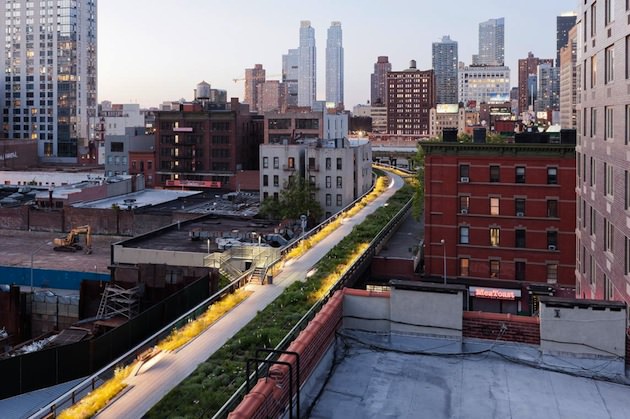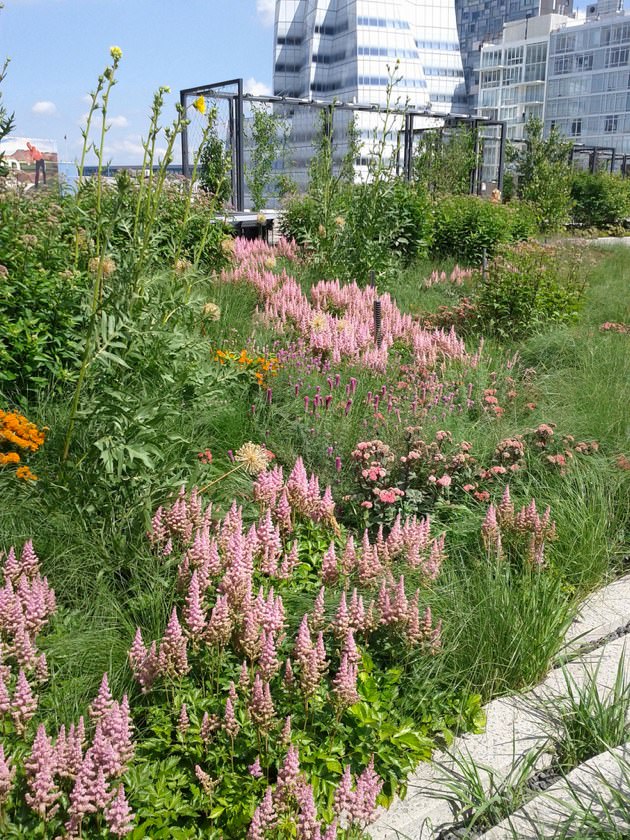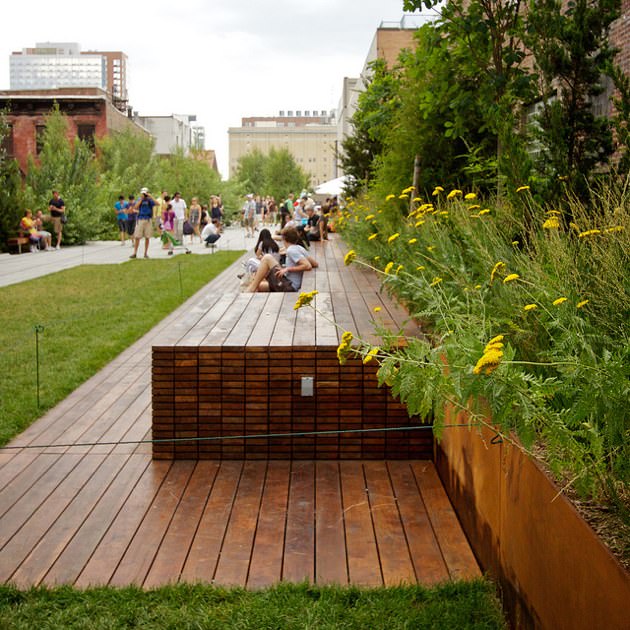Rarely do additions to works of architecture or engineering by the same designers who created the originals attract as much comment as the initial installments. Thus there was some question as to just how much excitement could be generated by the debut this June of the second segment of the High Line, which runs between West 20th and West 30th streets.
Happily, the same elated reaction that greeted the first segment occurred again this summer, as the newly completed middle portion of the High Line revealed that rather than being simply more of the same, the park is evolving into a much more varied experience than many had anticipated. The newly completed half-mile stretch feels different from the first in that its route is straighter and narrower (two tracks wide as opposed to four in the southernmost section). It makes fewer jogs and lacks the extravagantly sweeping arc of the northern end of the viaduct, which will bring the High Line to a dramatic culmination when the entire project is finished.
Because all the park’s components are being executed by the creative team comprised of two New York-based architectural and planning firms, James Corner Field Operations and Diller Scofidio + Renfro, along with the Dutch landscape architect Piet Oudolf, the High Line feels wholly consistent and yet never repetitive throughout its entire mile-and-a-half length. For example, at West 26th Street, the design team has created the Viewing Spur, a bleacher-like observation perch that is a virtual cousin of Tenth Avenue Square, the much larger wooden amphitheater at the viaduct’s widest point on West 17th Street. But the Viewing Spur differs from the Tenth Avenue Square because of a huge, empty oblong metal frame (the size of advertising billboards once mounted on the trestle’s parapet) that playfully demarcates the vista onto the street below like the outline of a movie screen.
Once again, Oudolf’s selection of botanical material is superb. This summer it featured such flowering perennials as allium, catmint, coral bells, cranebill, rosemary, salvia, and yarrow, along with trees and shrubs including chokeberry, holly, magnolia, redbud, roses, sassafras, and shadblow. His random-looking (though deliberately composed) planting beds simultaneously pay homage to the wildness of the High Line in its gone-to-seed phase and seamlessly accommodate the many functional requirements of a heavily trafficked pedestrian concourse.
The new segment also remedies one of the few objections the first phase of the design raised among environmentalists: the use of ipê, a tropical wood that activists have deemed ecologically destructive and unsustainable. Since then, the designers have specified reclaimed teak, which possesses the same weather-resistant properties as the controversial earlier selection.
Particular areas of the High Line have been given evocative names reminiscent of the Romantic nomenclature that Frederick Law Olmsted and Calvert Vaux bestowed on Central Park’s Belvedere Castle, Harlem Meer, Mineral Springs Pavilion, Rambles, and Sheep Meadow. Thus in the southernmost section of the High Line we find the Gansevoort Woodland and the Washington Grasslands, while in the newly opened center portion we now have the Chelsea Thicket, the Radial Bench, the Wildflower Field, and the Falcone Flyover—the latter a raised steel walkway that refers not to raptors on the wing but its donors (a high-flying hedge-fund manager and his wife).
The High Line’s founders and prime movers, Joshua David and Robert Hammond, offer an absorbing account of their heroic undertaking’s genesis and implementation in High Line: The Inside Story of New York’s Park in the Sky. The pair met in 1999 at a local community board meeting and there discovered their shared fascination with the disused elevated railway spur, which was constructed between 1929 and 1934 to bring raw materials and wholesale goods to the third-story receiving docks of warehouses, manufacturers, and food-processing plants near Manhattan’s Hudson shore.
The collaborators’ decade-long evolution from amateurs—David had been a magazine writer, Hammond a consultant to start-up companies—into seasoned urban planners is an uplifting coming-of-professional-age story in which two somewhat naïve and comically inexperienced enthusiasts wise up and learn what it takes to get things done in the City That Never Sleeps. Throughout, these oft-thwarted civic crusaders remained cheerily undaunted as they and overcame opposition from every quarter—an obstructionist neighborhood group called Chelsea Property Owners that inveighed against their plan, and hostile city officials who tried to thwart it.
A turning point came in 2001-2002, when the photographer Joel Sternfeld took a compelling series of images of the picturesquely decrepit train bed—a veritable urban prairie lush with nodding wildflowers and shimmering grasses—that are to the High Line what the muckraking photojournalist Jacob Riis’s depictions of New York City slum dwellings in the 1890s were to the cause of housing reform: strong artistic statements but also irresistible sales tools for agents of civic betterment.
Advertisement
The economic benefits New York City has reaped as a direct result of the High Line are significant. The first two of the project’s three segments have cost $133.6 million ($112.2 million of which has come from public funds, with the balance donated by private and corporate sponsors) and, in a remarkable return on investment, have spurred some $2 billion in ancillary development, primarily housing adjacent to the park, about 2,500 apartments thus far. Those units have been selling for an average $2,000 per square foot, nearly twice the Manhattan median of $1,028.
Prices in several of the new architect-designed apartment buildings near the High Line—which include designs by a roster of celebrated avant-garde figures including Neil Denari, Jean Nouvel, Lindy Roy, and Annabelle Selldorf— have lately rivaled the most expensive residential real-estate transactions in any other part of the city. For example, the penthouse atop Shigeru Ban’s eleven-story Metal Shutter Houses condominium of 2008-2011 on West 19th Street sold this summer for somewhere in the range of $13 million.
In addition, about a half-million square feet of new office space (the finest being Frank Gehry’s iceberg-like IAC building of 2003-2007 on West 18th Street) and a thousand hotel rooms (the best of which are in the Mexican architect Enrique Norten’s Hotel Americano of 2008-2011) have been added to the surrounding neighborhood. The High Line thus far has drawn more than five million visitors (about half from the New York metropolitan region, the rest domestic and foreign tourists), greatly benefiting local restaurants and retail businesses, and creating 12,000 jobs since 2009, an impressive figure during a period of soaring unemployment nationwide.
The “park in the sky” has also had a salutary effect on the local crime rate, with not a single serious offense reported on the High Line since it opened. That is largely attributable to Parks Enforcement Patrol officers who issue one quality-of-life summons every other day on average, mainly for drinking, but also for bicycles and dogs, which are prohibited atop the structure.
Another, less quantifiable means of crime control on the High Line is what the influential urbanologist Jane Jacobs termed “eyes-on-the-street”: day-and-night pedestrian traffic and a healthy contingent of neighborhood busybodies lead to fewer opportunistic offenses, both minor and major. Because the transformed viaduct threads its way through such a densely populated district, with many apartments and hotel rooms overlooking the walkway, Jacobs’s principle of informal but effective civilian surveillance is confirmed yet again.
This phenomenon’s flip side has been experienced by nonplussed High Line visitors who have been treated to exhibitionistic displays by guests at Ennead Architects’ Standard Hotel of 2005-2008, which straddles the walkway near the park’s southern terminus. One assumes that some residents in the many new apartments that face directly onto the viaduct’s midsection will follow suit.
Understandably, several American cities are attempting to replicate the High Line’s enormous success, an analog to the so-called Bilbao Effect after the sensation caused by Frank Gehry’s Guggenheim Museum Bilbao of 1991-1997. In Seattle, James Corner Field Operations has been asked to replace a tumbledown elevated highway on the city’s waterfront with a sequence of parks and recreation facilities, while in Atlanta the firm is undertaking a $2.8-billion conversion of the 22-mile-long railway loop that surrounds the city. But as James Corner himself has cautioned, “The High Line is not easily replicable in other cities. It’s not just ‘Build a cool park and they will come.’ It’s ‘Build a cool park and connect it to a framework.’”
Other communities have realized that it can cost less to recycle defunct infrastructure than to rip it out. A Philadelphia business improvement coalition has estimated that the city’s old Reading Viaduct could be rehabilitated for $14 million less than the $50 million it would take to knock it down. Those plans are tied to the recycling of an adjacent office tower into apartments, anticipating a real estate ripple effect of the sort experienced not only in the environs of the High Line, but also along New York’s Fifth Avenue a century and a half ago after the creation of Central Park.
David and Hammond’s High Line is above all an inspiring case study of how major city planning initiatives can be realized without either the authoritarian methods of Robert Moses—New York’s mid-twentieth-century public works czar, whose pursuit of vast infrastructure and urban clearance projects often ran roughshod over democratic procedures and working-class neighborhoods—or today’s characteristic commercially driven redevelopment schemes. The new book’s pictorial second half includes frightening images of the Metropolitan Transit Authority’s abortive 2007 attempt to redevelop the old Hudson Rail Yards—the largest remaining open parcel on the island—directly north of the High Line’s upper terminus. The byzantine Hudson Yards boondoggle, which would have resulted in yet another unneeded enclave of high-end office space and luxury housing, was everything that the High Line is not: inhuman in its colossal scale, undemocratic in its exclusivity, and geared to private profit rather than public benefit.
Advertisement
The sports stadium component of that controversial scheme was halted by an unlikely coalition of entrenched real-estate interests—for whom this speculation by a group of insiders went beyond even their compromised notions of transparency—and community activists who see this as a corporate land grab, but the project is far from dead. Without any unnecessary editorializing, Joshua David and Robert Hammond offer the image of that postmillennial Alphaville as a clear choice between two very different visions of their city, whose strength resides in its constant self-reinvention as an Isle of Joy for all.





